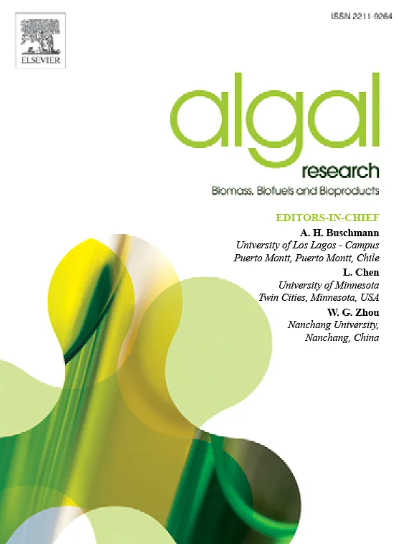铜绿微囊藻对单一和重复暴露于叶绿素提取物的不同反应
IF 4.6
2区 生物学
Q1 BIOTECHNOLOGY & APPLIED MICROBIOLOGY
Algal Research-Biomass Biofuels and Bioproducts
Pub Date : 2025-04-23
DOI:10.1016/j.algal.2025.104060
引用次数: 0
摘要
化感物质已被证明对微藻有抑制作用。然而,在反复暴露的情况下,关于它们对蓝藻的影响的知识有限,这与环境更相关。本研究从细胞密度、光合反应、抗氧化反应和微囊藻毒素(MCs)生成等方面比较了多次低剂量添加和单次高剂量添加狐尾藻提取物对铜绿微囊藻的影响。虽然累积暴露量相同(5 g/L),但我们的研究结果表明,重复低剂量暴露可促进藻类生长,而单次高剂量暴露可抑制细胞生长并降低光合活性,细胞密度抑制率最高可达58.2%。所有处理均发生氧化应激,过氧化氢酶(CAT)活性和超氧化物歧化酶(SOD)活性均有所增加。值得注意的是,细胞膜的氧化损伤仅发生在单次高剂量暴露中,丙二醛(MDA)含量从第2天到第5天分别是对照组的1.9倍、2.1倍、2.8倍和2.7倍。此外,重复低剂量暴露可促进mcd合成,mcyD基因丰度上调。细胞裂解可能是单次高剂量暴露处理中MCs释放增加的原因,因为mcyH基因丰度表明MCs的主动运输受到抑制。本研究揭示了铜绿假单胞菌对单一和重复暴露于化感化学物质的不同反应,揭示了蓝藻的对抗性控制。本文章由计算机程序翻译,如有差异,请以英文原文为准。
Differential responses of Microcystis aeruginosa to single and repeated exposure to Myriophyllum spicatum extracts
Allelochemicals have been proven to be effective in inhibiting microalgae. However, there is limited knowledge regarding their effect on cyanobacteria in the case of repeated exposure, which is more environmentally relevant. In the present study, the effects of multiple low-dosage additions and single high-dosage addition of Myriophyllum spicatum extracts toward Microcystis aeruginosa were compared based on cell density, photosynthetic response, antioxidative response, and microcystins (MCs) production. Although the cumulative exposure content of M. spicatum extracts was the same (5 g/L), our results showed that algal growth was promoted in repeated low-dosage exposure, whereas single high-dosage exposure inhibited cell growth and decreased photosynthetic activity with the highest inhibition rate of cell density reaching 58.2 %. Oxidative stress occurred in all treatments exposed to M. spicatum extracts, as indicated by the increased catalase (CAT) activity and superoxide Dismutase (SOD) activity. It is noteworthy that oxidative damage to the cell membrane only occurred in single high-dosage exposure as indicated by the malondialdehyde (MDA) contents, which were 1.9, 2.1, 2.8, and 2.7 times higher than that of the control group from day 2 to day 5, respectively. Moreover, repeated low-dosage exposure could promote MC synthesis as indicated by the up-regulated mcyD gene abundance. Cell lysis may be responsible for the increased MCs release in single high-dosage exposure treatment since active transport of MCs was suppressed as indicated by mcyH gene abundance. This study revealed differential responses of M. aeruginosa to single and repeated exposure to allelochemicals, shedding light on the allopathy control of cyanobacteria.
求助全文
通过发布文献求助,成功后即可免费获取论文全文。
去求助
来源期刊

Algal Research-Biomass Biofuels and Bioproducts
BIOTECHNOLOGY & APPLIED MICROBIOLOGY-
CiteScore
9.40
自引率
7.80%
发文量
332
期刊介绍:
Algal Research is an international phycology journal covering all areas of emerging technologies in algae biology, biomass production, cultivation, harvesting, extraction, bioproducts, biorefinery, engineering, and econometrics. Algae is defined to include cyanobacteria, microalgae, and protists and symbionts of interest in biotechnology. The journal publishes original research and reviews for the following scope: algal biology, including but not exclusive to: phylogeny, biodiversity, molecular traits, metabolic regulation, and genetic engineering, algal cultivation, e.g. phototrophic systems, heterotrophic systems, and mixotrophic systems, algal harvesting and extraction systems, biotechnology to convert algal biomass and components into biofuels and bioproducts, e.g., nutraceuticals, pharmaceuticals, animal feed, plastics, etc. algal products and their economic assessment
 求助内容:
求助内容: 应助结果提醒方式:
应助结果提醒方式:


